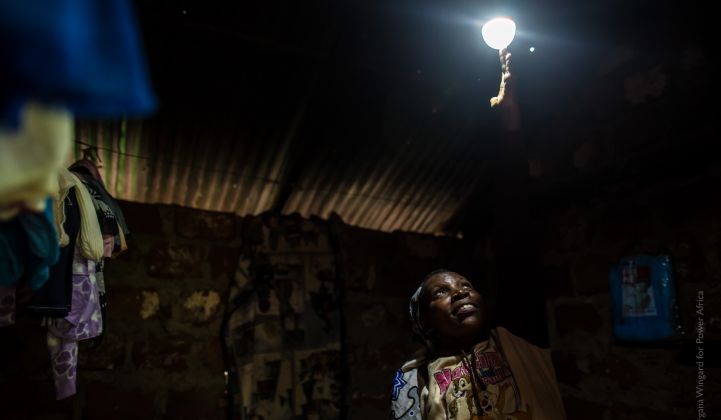There is an intensifying move in the developing world to bring modern energy services to the more than 1 billion people who live without them.
Often the starting point is solar-powered light-emitting diodes. The bright, low-energy lights can replace far more dangerous forms of lighting, including candles and kerosene lanterns.
Besides lowering indoor pollution and providing better light, the move to solar LEDs could also create approximately two million new jobs, according to new research from Lawrence Berkeley National Laboratory. The study was published in the journal Energy for Sustainable Development.
“People like to talk about making jobs with solar energy, but it’s rare that the flip side of the question is asked -- how many people will lose jobs who are selling the fuels that solar will replace?” Evan Mills, Berkeley Lab researcher and lead author, said in a statement. “We set out to quantify the net job creation. The good news is, we found that we will see many more jobs created than we lose.”
The study focused on those who could not even afford a small home solar system, which might power lights, appliances such as a TV and phone chargers. It looked at the approximately 112 million households that can only afford entry-level solar lanterns. There are about 274 million households total without access to modern electricity, but more than half of those could afford more sophisticated upgrades, such as small off-grid solar systems, or access to the grid.
Currently, solar LED lighting already supports more jobs than fuel-based lighting, which provides about 150,000 jobs worldwide. Mills surveyed major solar LED companies and found that for every 10,000 people living off-grid, about 38 clean lighting jobs are created.
This does not include the manufacturing of LED components and their assembly, which often take place outside of the countries where the lights are used. Instead, Mills focused on in-country sales and distribution, where the most jobs would be affected as LED lights replace traditional sources.
But in the case of kerosene and candles, they are rarely sold alone. “The emerging solar-LED lighting alternatives are being sold through many of these same outlets, and thus the revenue can remain within that sector even as technology/ fuel choices evolve,” writes Mills. Wicks and candles can be sold alongside everything from safety pins and buttons to shoe polish and toothbrushes.
When SolarAid interviewed kerosene vendors in nearly 40 markets in Malawi and Kenya in 2013, the nonprofit found the shift from kerosene was already happening, although it didn’t seem to affect business overall.
Vendors reported about a 50 percent reduction in sales of kerosene over the previous year, and most said it was attributable to the availability of LED flashlights and solar lanterns, although kerosene shortages were a factor in some cases. One vendor spoke of the kerosene business “dying a natural death” and noted that it did not seem to be a disruptive force.
As of mid-2025, about 44 million solar LED lanterns had been sold, at a rate of about 10 million per year. For the approximately 112 million households, Mills assumed each house could afford about three solar LED lights, each with a service life of three years. With the ongoing replacement rate, and a job intensity of about 17,000 jobs per million lanterns, the total figure of employment would be approximately 2 million jobs.
The effect of cheaper, better lighting means even more income to spend or save. In the Philippines, for example, one study found homeowners saved about 5 percent of income when switching from kerosene to LEDs. For every 20 households, that is equal to the income attained via a full-time job. In aggregate, the savings from switching to LEDs would roughly equal the income of an additional 6 million jobs.
The effect on businesses, and not just households, is even more profound. For the night-fishing sector in sub-Saharan Africa, the cost of lighting can be as high as half of wholesale revenues, according to Mills. Various studies have found the increasing workplace electrification increases revenues.
Lighting is, of course, just the first step, but a necessary one as more comprehensive forms of electrification are invested in. It is not an either/or proposition. Centralized electrification is not keeping pace with population growth, and the International Finance Corporation estimates central electrification is only suitable for less than one-quarter of the world’s unelectrified households, according to the study.
Lastly, “conversion from fuel-based lighting to the central grid would yield negligible net job creation compared to the off-grid pathway,” writes Mills. “It would also shift jobs from lower-income villagers to demographically quite different utility employees.”
There is enormous growth potential in all forms of energy generation in developing markets. Power Africa, for instance, has a goal of bringing 60 million new grid connections and 30,000 megawatts of clean power to the continent, both in large- and small-scale projects. The global off-grid solar market alone is expected to top $3 billion by 2020.
The impact of these investments will be tremendous. “The transition away from kerosene and other fuel-based lighting in developing countries is now irreversibly underway,” Mills concludes. “The transition will create more than 10 times more jobs than it displaces.”



